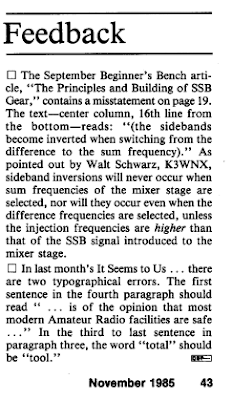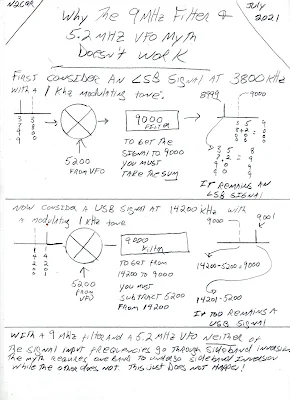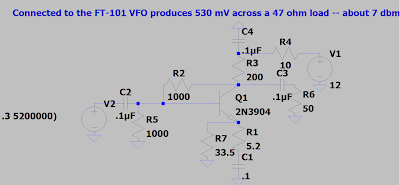Serving the worldwide community of radio-electronic homebrewers. Providing blog support to the SolderSmoke podcast: http://soldersmoke.com
Podcasting since 2005! Listen to Latest SolderSmoke
Wednesday, July 28, 2021
50 Shades of Homebrew? PH2LB's Shack and NanoVNA Adapters
Tuesday, July 27, 2021
QST Recognized Error on Sideband Inversion, But Continued to Make the Same Mistake
Monday, July 26, 2021
QST Repeatedly Got Sideband Inversion Wrong
It kind of pains me to do this. These articles are from a long time ago, and the author is an esteemed Silent Key, but the myth about the origins of the USB/LSB convention is still out there, and as a homebrewer of SSB gear I feel obligated to point out these examples of the error that that myth is based on.
Last Friday, Pete WB9FLW and I were talking about homebrewing SSB rigs. I recommended a series of QST articles by Doug DeMaw. "Beginner's Bench: The Principles and Building of SSB Gear" started in QST in September 1985. There were at least five parts -- it continued until January 1986. (Links to the series appear below.) I hadn't looked at these articles in years, but when I did, a big mistake jumped right out at me: In the first installment, on page 19, Doug makes the same mistake that he made in his Design Notebook:
"Now comes the conversion section of our SSB generator. We must move (heterodyne) the 9-MHz SSB signal to 3.75-4.0 MHz. Our balanced mixer works just as it does in a receiver. That is, we inject the mixer with two frequencies (9 MHz and 5 MHz) to produce a sum or a difference output frequency (9 - 5 = 4 MHz, or 9 +5 = 14 MHz) If we are to generate 75 meter SSB energy, we must chose the difference frequency. We could build an 20-meter SSB transmitter by selecting the sum of the mixer frequencies. The RF amplifiers and filter (FL2) that follow would then have to be designed for 14-MHz operation. In fact, many early two-band homemade SSB transmitters were built for for 75 and 20 meters in order to use this convenient frequency arrangement. The use of upper sideband on 20 meters and lower sideband on 75 meters may be the result of this frequency arrangement (the sidebands become inverted when switching from the difference to the sum frequency.) "
Those last two sentences are incorrect. They repeat the "Myth," or the "Urban Legend" about the origins of the LSB/USB convention. Contrary to what many hams now believe, with 9 MHz filter and a 5.2 MHz BFO it takes more than just switching from sum frequency to difference frequency to invert one of the sidebands.
There are two conditions needed for sideband inversion to take place:
1) You have to be taking the difference product (DeMaw got that right)
2) The unmodulated (VFO or LO) signal must be larger than the modulated signal. (DeMaw and the ARRL obviously missed that part. Repeatedly.)
This is another way of stating the simple, accurate and useful Hallas Rule: Sideband inversion only occurs when you are subtracting the signal with modulation FROM the signal without modulation.
For DeMaw's claim to be correct, one of the SSB signals going into the balanced mixer would have to invert, and the other would have to not invert. Let's see if that happens: He has the sideband signal being generated at 9 MHz and the VFO running around 5 MHz.
9 - 5 = 4 But we are not subtracting the modulated signal FROM the unmodulated signal. SO NO INVERSION
9 + 5 = 14 We are not subtracting at all. SO NO INVERSION.
Sunday, July 25, 2021
Possible Victory for Frank Jones and the FMLA? Could We Get the 5 Meter Band Back?
EI7GL reports some very interesting IARU activity that could possibly result in the 5 Meter band coming back to amateur radio use:
"The 60 MHz or 5 metre band has the potential to be a future allocation for the Amateur Radio service. The International Amateur Radio Union (IARU) are currently encouraging member societies to try and obtain small allocations at 40 MHz and 60 MHz."
https://ei7gl.blogspot.com/p/60-mhz.html
Regaining 5 meters was, of course, the objective of Frank Jones and the Five Meter Liberation Army. Wouldn't it be great of Michael Hopkins' fictional tale actually ended up coming true!
Saturday, July 24, 2021
Thursday, July 22, 2021
The Unicorn! A 75 LSB /20 USB Receiver (That Can't Work)
Wednesday, July 21, 2021
Ganymede and Jupiter as seen by Juno
Tuesday, July 20, 2021
Mythbuster Videos 8 and 9 -- The Old Military Radio Net plus "Zero Beat and The Vertical Skirts"
Monday, July 19, 2021
Michael Newton Hopkins, AB5L, Author of the FMLA series
Sunday, July 18, 2021
Alan Wolke W2AEW's Great Video on Using NanoVNA to Measure Amplifier Input Impedance and Gain
Saturday, July 17, 2021
Mythbuster Video #7: Bandswitch, Reverse Polarity Protection, CW with Clarifier Offset
I have the speaker mounted on the front of the board. I kind of like it like that. I now have a bandswitch, and reverse polarity protection (no more living dangerously for me). That Yaesu VFO clarifier circuit might prove useful should I decide to give this rig CW capability. I once again find myself thinking that I might never put this in a metal box. Frank Jones had the right idea.
Friday, July 16, 2021
Mythbuster Video #6 -- On to 20 Meters (But With Bandpass Filter Woes). Please help solve the mystery!
Thursday, July 15, 2021
Wednesday, July 14, 2021
Mythbuster Video #4 -- First Signals, 75 meter Bandpass Filter, Yaesu VFO output
Tuesday, July 13, 2021
Mythbuster Video #3 -- Using the VFO from a Yaesu FT-101
Monday, July 12, 2021
Mythbuster Video #2 -- 10 Pole Crystal Filter
Sunday, July 11, 2021
A Video Series on the Mythbuster 75/20 Rig -- Video #1
Friday, July 9, 2021
The Woz on Homebrewing and The Right to Repair
Thursday, July 8, 2021
A Great Line from the FMLA Articles
The narrator was in CW contact on 6 meters with a guy who turns out to be... Frank Jones.
Sunday, July 4, 2021
Romanian Mighty Mite and Ciprian's Knack Story
Saturday, July 3, 2021
M0NTV's Latest Breadbox Rig -- The Radio Gods Have Spoken (TRGHS)!
Thursday, July 1, 2021
Summer Reading for Homebrewers: Frank Jones and the FMLA by Michael Hopkins AB5L (SK)
I read these stories when they were first coming out and I really liked them. Here are all the FMLA episodes. Don't try to read them all in one sitting. Spread them out. Savor them. Think about the message that Frank was sending us.
All of the FMLA episodes: https://tomfhome.files.wordpress.com/2019/12/frank_and_the_fmla.pdf
--------------------------------------
Related articles, books and links:
Frank's obit: https://www.pressdemocrat.com/article/news/frank-jones/
Frank's book "5 Meter Telephony": https://w5jgv.com/downloads/5-Meter%20Radiotelephony%20by%20Frank%20Jones.pdf
Frank's 1937 Antenna Handbook: http://rfcec.com/RFCEC/Section-3%20-%20Fundamentals%20of%20RF%20Communication-Electronics/23%20-%20RADIO%20ENGINEERING%20DATA/1937%20-%20Jones%20Antenna%20Handbook%20(By%20Frank%20C.%20Jones).pdf
About the author, Michael Hopkins AB5L: https://www.rantechnology.com/index.cfm?key=view_resource&TransKey=615604E8-9DAA-40A3-9E48-4160806D893D&CategoryID=8E884CE4-9CED-4957-872B-5EBDB058D540&Small=1
The World's Largest Heathkit Collection (Video)
Wednesday, June 30, 2021
10 Pole Crystal Filter Passband as Seen in Antuino and NanoVNA
Tuesday, June 29, 2021
Jack NG2E's Pebble Crusher
Check out NG2E's Pebble Crusher homebrew transmitter. Doug DeMaw would be enormously pleased.
Jack will no-doubt have this 250 mW rig on the some peak along the Shenandoah Valley, handing out QSOs to SOTA fans.
Jack's blog page has a really nice video on this project:
https://jackhaefner.blogspot.com/2021/06/pebble-crusher-40m-xmtr.html
Saturday, June 26, 2021
SolderSmoke Podcast #231 -- Travel, SST, Mythbusting, Filters, TIAS, NanoVNAs, DC RX in SPRAT, Drake A Line, Spillsbury, STICKERS! Mailbag
Thursday, June 24, 2021
Radio Netherlands -- Bonaire Relay Station
Friday, June 18, 2021
Jean Shepherd on CW, and Strange Propagation -- QRP!
Thursday, June 17, 2021
The Stubborn Myth about USB and LSB
It has been repeated so often and for so long that many of us have come to believe it. I myself believed it for a while. Like many myths, it has a ring of truth to it. And it is a simple, convenient explanation for a complex question:
Why do ham single sideband operators use LSB below 10 MHz, but USB above 10 MHz?
Here is the standard (but WRONG) answer:
In the early days of SSB, hams discovered that with a 9 MHz SSB generator and a VFO running around 5.2 MHz, they could easily reach both 75 meters and 20 meters (True). And because of sideband inversion, a 9 MHz LSB signal would emerge from the mixer as an LSB signal (True), while the 20 meter signal would emerge -- because of sideband inversion -- as a USB signal (FALSE!) That sideband inversion for the 20 meter signal explains, they claim, the LSB/USB convention we use to this day.
Why this explanation is wrong:
There is a very simple rule to determine if sideband inversion is taking place: If you are subtracting the signal with the modulation FROM the signal without the modulation (the LO or VFO) you will have sideband inversion. If not, you will NOT have sideband inversion.
So, you just have to ask yourself: For either 20 or 75 are we SUBTRACTNG the Modulated signal (9 MHz) from the unmodulated signal (5.2 MHz)?
For 75 meters we have: 9 MHz - 5.2 MHz = 3.8 MHz NO. We are not subtracting the modulated signal from the unmodulated signal. There will NOT be sideband inversion.
For 20 meters we have 9 MHz + 5.2 MHz = 14.2 MHz. NO. No subtraction here. No sideband inversion.
So it is just arithmetically impossible for there to be the kind of happy, easy, and convenient USB/LSB situation described so persistently by the myth.
---------------------------------
We discussed this several times on the podcast and in the blog:
https://soldersmoke.blogspot.com/2015/05/sideband-inversion.html
https://soldersmoke.blogspot.com/2012/05/usblsb-urban-legend-debunked.html
This myth shows up all over the place:
We see the myth here:
http://n4trb.com/AmateurRadio/Why%20The%20Sideband%20Convention%20-%20formatted.pdf
Here the web site owner warns that this is "highly controversial." Really? Arithmetic?
The myth is very old. Here is a clip from a 1966 issue of "73" magazine:
https://worldradiohistory.com/
Finally, to my disappointment, I found the myth being circulated by the ARRL, in the 2002 ARRL Handbook page 12.3:
Tuesday, June 15, 2021
Hi Def 360 Degree Panorama from the Mars Perseverance Rover
Monday, June 14, 2021
M0NTV's Latest FB SSB Transceiver
Santo Domingo Shack on 12th Floor Balcony -- SST QRP CW
Saturday, June 12, 2021
Good News! The Termination Event May Be Coming Soon! Solar Cycle 25 Could Rival Cycle 19!
Thanks to Thomas over at SWLing Post for alerting us to this important news.













































